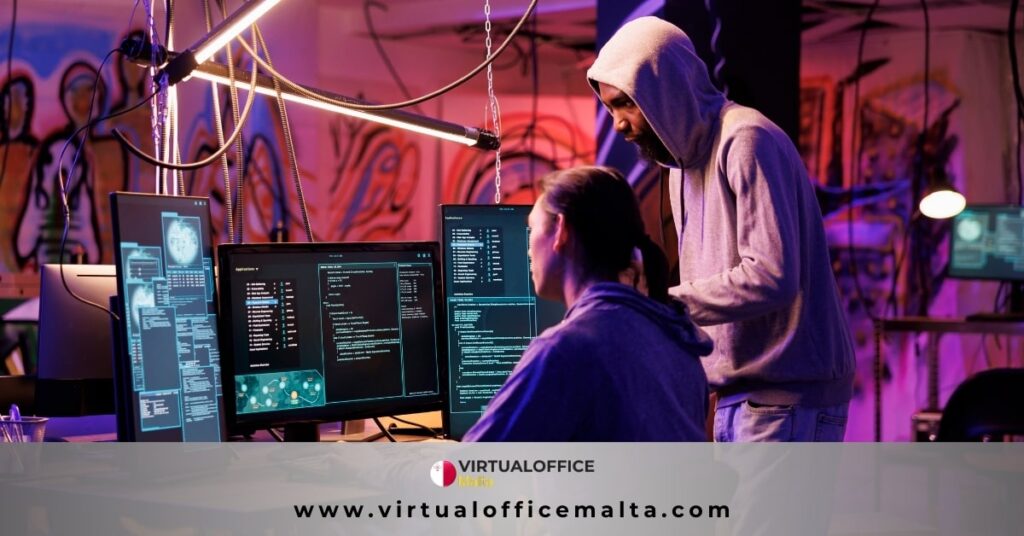In today’s digital world, businesses are increasingly at risk from cyberattacks. As more employees work remotely and virtual offices become common, the threat from cybercriminals grows. Understanding cybersecurity for business is more important than ever to keep your company safe. Let’s explore how to protect your virtual office from these rising cyber threats.
What is Cybersecurity Awareness?
Cybersecurity for business involves protecting internet-connected systems, like computers, networks, and data, from cyberattacks. For businesses, this means safeguarding sensitive information and preventing unauthorized access. Cybersecurity awareness is about helping companies understand the risks they face and how to defend against them.
Cybersecurity for Business
When we talk about cybersecurity for business, we mean the steps, tools, and technologies companies use to protect their digital infrastructure and data. This includes preventing attacks, detecting them early, and responding to them if they occur. With virtual offices, cybersecurity must also cover employees’ home networks, mobile devices, and third-party services to ensure complete protection.
Why Cybersecurity is Important for Businesses Today
Cyberattacks can seriously harm a business, causing financial losses, damaging their reputation, and even resulting in legal trouble. Small businesses are often targeted because they may not have strong security measures. A data breach can expose sensitive information, like customer data, leading to fines and other penalties.
Cybersecurity for Business: The Growing Risks in Virtual Offices
As remote work becomes more common, virtual offices have opened new doors for cybercriminals. These environments are often more vulnerable to cyberattacks because they rely on employees working from different locations, often with weaker security measures.
Common Cybersecurity Threats for Business
Understanding the main threats is key to defending against cyberattacks. Some of the most common cybersecurity risks for businesses include:
Cybersecurity for Business: Phishing Attacks
Phishing is when hackers trick people into revealing sensitive information, like passwords, by pretending to be a trusted source. For example, a scammer might send an email pretending to be a service provider and ask the employee to click a harmful link or share login details.
Malware & Ransomware
Malware is software designed to harm or steal information from a system. Ransomware is a type of malware that locks up a company’s data until a ransom is paid. Virtual offices, where employees access data from various places, increase the risk of malware infections.
Insider Threats
Insider threats occur when someone within the company, either by accident or on purpose, causes a security breach. Employees may unknowingly share sensitive data or fall for phishing attacks, which leads to security problems.
Cybersecurity for Business:DDoS Attacks
A Distributed Denial of Service (DDoS) attack overwhelms a company’s services with too much traffic, causing them to crash. Businesses relying on cloud services for virtual offices are particularly vulnerable to these types of attacks.
Cybersecurity for Remote Workers
The shift to remote work has introduced new cybersecurity challenges. While virtual offices offer flexibility, they also come with unique security risks that need to be managed.
Remote Work Security Challenges
Remote employees often use personal devices and unsecured networks, which can introduce vulnerabilities. It can also be difficult to apply consistent security policies across all locations and devices.
Cybersecurity for Business: Secure Access for Remote Teams
To protect remote workers, businesses should use secure methods like Virtual Private Networks (VPNs) to encrypt data exchanged between employees and company servers. Another approach is Zero Trust Architecture (ZTA), which assumes no one is trusted by default and enforces strict verification before granting access.
Safe Communication in Virtual Offices
Communication between employees should be encrypted to keep hackers from stealing sensitive data. Employees also need to be trained to recognize phishing attempts and use strong, unique passwords.
Best Practices for Cybersecurity for Business
To protect your virtual office, it’s essential to follow these best practices:
Strong Password Policies
One of the easiest ways to strengthen cybersecurity for business is by enforcing strong passwords. Passwords should be long, unique, and changed regularly. Encouraging employees to use password managers can prevent weak or reused passwords.
Multi-Factor Authentication (MFA)
Multi-factor authentication adds an extra layer of security by requiring a second form of verification, such as a text message code, before granting access. This significantly reduces the risk of unauthorized access, even if a password is stolen.
Data Encryption
Encryption turns sensitive information into unreadable code that only authorized users can access. Businesses should use encryption for both stored data (at rest) and data being transferred over the internet (in transit).
Securing Cloud-Based Services
Since virtual offices rely on cloud services, it’s critical to ensure these systems are secure.
Cloud Vulnerabilities
Cloud services can be risky if they are not configured correctly or lack strong security controls. Companies need to ensure their cloud providers follow strict security measures to protect data.
Encrypting Data in the Cloud
All data stored in the cloud should be encrypted. In addition, businesses must tightly control access to their cloud services. Many cloud providers offer encryption, but it’s important to understand how the data is protected.
Third-Party Vendors and Cloud Security
Third-party vendors may also have access to company data, so it’s important to check that these vendors follow high-security standards, such as ISO/IEC 27001, to ensure data protection.
FAQs About Cybersecurity for Business
What is the most common cybersecurity threat for businesses?
Phishing is the most common cybersecurity threat facing businesses today. Attackers use fake emails or websites to trick employees into sharing sensitive information, such as passwords or financial data. Phishing remains a major concern because it exploits human error, which can be difficult to guard against without proper training.
How can businesses protect their remote workers?
To protect remote workers, businesses can implement several cybersecurity measures:
- Use secure access protocols, like Virtual Private Networks (VPNs), to encrypt data.
- Require multi-factor authentication (MFA) to add an extra layer of security.
- Implement encrypted communication tools for secure messaging and file sharing. These measures strengthen cybersecurity for business by protecting remote employees from potential cyber threats.
What is multi-factor authentication, and why is it important for business security?
Multi-factor authentication (MFA) is a security process that requires two or more verification methods before granting access to sensitive systems. For example, after entering a password, a user might need to enter a code sent to their mobile device. MFA is crucial for business security because it reduces the risk of unauthorized access, even if passwords are compromised.
What are the benefits of cybersecurity insurance for businesses?
Cybersecurity insurance provides businesses with financial protection in the event of a cyberattack. The benefits include:
- Coverage for legal fees and fines.
- Assistance with data recovery and breach investigations.
- Compensation for business interruption or revenue loss due to an attack. Investing in cybersecurity insurance can help businesses recover quickly after a breach and reduce financial losses.
Why is regular cybersecurity training important for businesses?
Regular cybersecurity training is essential for businesses because it educates employees on how to identify and respond to potential threats. Training helps staff recognize phishing emails, use strong passwords, and follow security best practices. By reducing human error, regular training improves overall cybersecurity for business and lowers the chances of a successful cyberattack.
What should a strong incident response plan include for businesses?
A strong incident response plan should include the following key components:
- Clear steps for identifying and reporting a security breach.
- Guidelines for containing and resolving the incident.
- Communication protocols to inform stakeholders, including employees, customers, and legal authorities. An effective incident response plan ensures that businesses can act quickly during a cyberattack, minimizing damage and ensuring a faster recovery.









